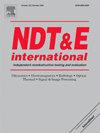基于二维激光超声行列寻址阵列的三维空间相干成像
IF 4.5
2区 材料科学
Q1 MATERIALS SCIENCE, CHARACTERIZATION & TESTING
引用次数: 0
摘要
三维(3D)成像是超声无损检测(NDT)的一个重要进展。与一维(1D)阵列相比,基于二维(2D)阵列的全矩阵捕获(FMC)所需元素和采样通道呈指数增长,从根本上限制了阵列孔径和成像分辨率。行-列寻址(RCA)阵列创新性地通过交替行-列寻址将元素计数从N × N减少到N + N,显著降低了信道需求和采样数据量。本研究开创了二维RCA阵列的全光学方法,旨在实现身体缺陷的三维非接触成像。在方法上,研究分为三个阶段:首先,为了产生能量均匀的圆柱形波,采用光调制技术产生细长的均匀激光光斑,实现激光超声正交复合扫描阵列数据采集;其次,建立了用于人工盲孔和模拟腐蚀缺陷多模态表征的三维空间相干成像算法;最后,对几种阵列配置和成像算法进行了系统比较,并分析了优化策略。实验结果表明,激光超声RCA阵列成像可以有效地重建三维缺陷的几何形状和尺寸特征。多模可视化成功地解决了缺陷区域之间的几何变化。这项工作介绍了一种新的非接触式阵列检测方法,促进了超声无损检测从二维到三维的过渡。研究结果为高分辨率体积检测的自适应算法选择和系统优化提供了重要见解。本文章由计算机程序翻译,如有差异,请以英文原文为准。
Three-dimensional spatial coherent imaging based on two-dimensional laser ultrasonic row-column addressing array
Three-dimensional (3D) imaging represents a crucial advancement in ultrasonic non-destructive testing (NDT). Compared with one-dimensional (1D) arrays, full matrix capture (FMC) based on two-dimensional (2D) arrays experiences exponential growth in required elements and sampling channels, fundamentally constraining array aperture and imaging resolution. The row-column addressing (RCA) array innovatively reduces the element count from N × N to N + N through alternating row-column addressing, significantly decreasing channel requirements and sampling data volume. This study pioneers a fully optical approach for 2D RCA array, aiming to achieve 3D non-contact imaging of body defects. Methodologically, the research progresses through three phases: First, to generate uniform energy cylindrical waves, an optical modulation technique was developed to create elongated homogenized laser spots, enabling laser ultrasonic orthogonal compound scanning for array data acquisition. Second, a 3D spatial coherence imaging algorithm was established for multimode characterization of artificial blind holes and simulated corrosion defects. Finally, systematic comparisons of several array configurations and imaging algorithms were conducted, with optimization strategies analyzed. Experimental results demonstrate that laser ultrasonic RCA array imaging effectively reconstructs 3D defect geometries and dimensional features. Multimode visualization successfully resolves geometrical variations across defect regions. This work introduces a novel non-contact array inspection methodology, facilitating the transition from 2D to 3D in ultrasonic NDT. The findings provide critical insights into adaptive algorithm selection and system optimization for high-resolution volumetric inspection.
求助全文
通过发布文献求助,成功后即可免费获取论文全文。
去求助
来源期刊

Ndt & E International
工程技术-材料科学:表征与测试
CiteScore
7.20
自引率
9.50%
发文量
121
审稿时长
55 days
期刊介绍:
NDT&E international publishes peer-reviewed results of original research and development in all categories of the fields of nondestructive testing and evaluation including ultrasonics, electromagnetics, radiography, optical and thermal methods. In addition to traditional NDE topics, the emerging technology area of inspection of civil structures and materials is also emphasized. The journal publishes original papers on research and development of new inspection techniques and methods, as well as on novel and innovative applications of established methods. Papers on NDE sensors and their applications both for inspection and process control, as well as papers describing novel NDE systems for structural health monitoring and their performance in industrial settings are also considered. Other regular features include international news, new equipment and a calendar of forthcoming worldwide meetings. This journal is listed in Current Contents.
 求助内容:
求助内容: 应助结果提醒方式:
应助结果提醒方式:


